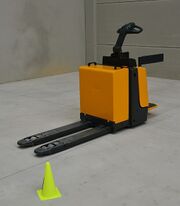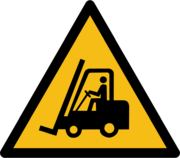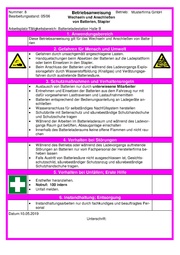A pallet truck is an industrial truck with or without electric drive. It can be used to transport transport pallets, lattice boxes and corresponding conveying aids on level surfaces. Another colloquially used name is> ant.
Description

A pallet truck has two metal tines (fork) that can be pushed under the pallet. In front of the tines there are small, downwardly extendable load rollers, on the other side there are one or two steerable rollers. With the load and castors, the lifting tines can be adjusted parallel to the ground in height with a hydraulic lifting cylinder and a linkage. This way, the pallet can be raised for shipping. The handle is used for moving and steering, and in non-powered devices as a lever for a hydraulic pump, which feeds the lifting cylinder. On the handle or near the steering axle is the operating option for the hydraulic valve (lifting / driving / lowering). Electric pallet trucks follow the operator by means of further switching handles.
Safety regulations

- In Germany, an annual UVV test (according to the guidelines of the employers' liability insurance association) is mandatory for an electric pallet truck.
- A certificate of competence (driving license) for driving electric pallet trucks is not required if the pallet truck is controlled by a traveling driver, also called a pedestrian. In this case, according to the German Employers' Liability Insurance Ordinance § 7 (2) BGV D27, instruction of the driver in the handling of the lift truck is sufficient. The assignment of the driver does not have to be in writing in this case.[1]

Instruction
- Instructions must always be given when a new employee comes to a work area and they are, therefore, also mandatory for apprentices, trainees, temporary staff or leasing staff. The instruction should alert the employee to possible hazards, communicate the correct handling of the equipment and the loads to be transported and teach him necessary precautions for his own safety and the safety of others. The instructions may be delegated by the employer, usually to the company supervisor. The supervisor can observe the emplopyee after instructions have been given and intervene if necessary. Traffic routes, signage, charging stations or other relevant business units must be taught as part of the operational training. Each instruction must be documented in writing and signed by the instructed person.
Operating instructions
References